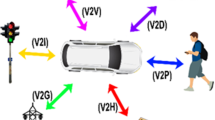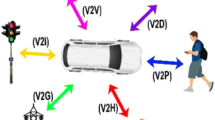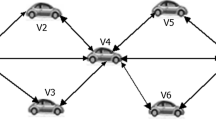Abstract
Vehicular Ad-hoc Networks (VANET) is a vital technology for futuristic Intelligent Transport System (ITS). VANET is a sub level of Mobile Ad-hoc Network (MANET), which establishes connectivity among vehicles with wireless medium. Once the vehicles communicate directly with each other, then there arises a new era for vehicle and road safety applications. At the same time creates new challenges by mobility of vehicles with dynamic network environment. As ITS keeps developing, there is a necessity to enhance safety application with high packet delivery rates, and reduce packet latency. This paper proposes a hybrid routing protocol called Directional-Cache Agent based Location Aided Routing (D-CALAR). D-CALAR is a combination of position based and Geocast routing. A mathematical representation for D-CALAR protocol is derived to analyze its performance. Simulation has been carried out using NS-2.33 and VanetMobiSim. From the simulated result, it seems that D-CALAR routing protocol outperformed DD-LAR, PSCAR and ID-LAR in terms of Packet Delivery Ratio, Re-transmission Ratio, Average Delay and Hop Count.











Similar content being viewed by others
References
Violence and Injury Prevention - Global status report on road safety 2013, World Health Organization. (2013). http://www.who.int/violence_injury_prevention/road_safety_status/2013/en/. Accessed 10th July 2018.
Road Accidents in the U.S. - Statistics and Facts, The Statistics Portal. (2016). https://www.statista.com/topics/3708/road-accidents-in-the-us/. Accessed 10th July 2018.
Reduction in road death 2017, The Times of India. (2017). https://timesofindia.indiatimes.com/india/2017-saw-3-decline-in-road-accident-deaths/articleshow/62828118.cms. Accessed 10th July 2018.
Total Number of Persons Killed in Road Accidents in India, Government of India. (2016). https://data.gov.in/catalog/total-number-persons-killed-road-accidents-india. Accessed 10th July 2018.
Krishnan, S., Geetha, K., Basri, R. (2018). Road accidents and road safety measures in Tamilnadu: An analysis, Government of Tamil Nadu-state transport authority. http://www.tn.gov.in/sta/accident_analysis_140318.pdf.
Abbasi, I., & Shahid Khan, A. (2018). A review of vehicle to vehicle communication protocols for VANETs in the urban environment. Future Internet, 10, 14. https://doi.org/10.3390/fi10020014.
Hanshi, S. M., Wan, T.-C., Kadhum, M. M., & Bin-Salem, A. A. (2018). Review of geographic forwarding strategies for inter-vehicular communications from mobility and environment perspectives. Vehicular Communications, 14, 64–79. https://doi.org/10.1016/j.vehcom.2018.09.005.
Al-Sultan, S., Al-Doori, M. M., Al-Bayatti, A. H., & Zedan, H. (2014). A comprehensive survey on vehicular Ad Hoc network. Journal of Network and Computer Applications, 37, 380–392. https://doi.org/10.1016/j.jnca.2013.02.036.
Campolo, C., Molinaro, A. (2010). Vehicle-to-roadside multihop data delivery in 802.11p/WAVE vehicular ad hoc networks. In IEEE global telecommunications conference GLOBECOM 2010, Miami, FL, pp. 1–5. https://doi.org/10.1109/glocom.2010.5683430.
Chen, Q., Jiang, D., Taliwal, V., Delgrossi, L. (2006). IEEE 802.11 based vehicular communication simulation design for NS-2, VANET ‘06. In Proceedings of the 3rd international workshop on vehicular ad hoc networks, pp. 50–56.
Teixeira, F. A., e Silva, V. F., Leoni, J. L., Macedo, D. F., & Nogueira, J. M. S. (2014). Vehicular networks using the IEEE 802.11p standard: An experimental analysis. Vehicular Communications, 1(2), 91–96.
Jafari, A., Al-Khayatt, S., Dogman, A. (2012). Performance evaluation of IEEE 802.11p for vehicular communication networks. In 8th International symposium on communication systems, networks & digital signal processing (CSNDSP), Poznan, pp. 1–5. https://doi.org/10.1109/csndsp.2012.6292712.
Gurumoorthi, E., & Ayyasamy, A. (2017). A comprehensive study for Geocast routing and its tool on VANET. International Journal of Pure and Applied Mathematics, 117(15), 1177–1184.
Amoroso, A., Marfia, G., & Roccetti, M.. (2012). GPS position errors in VANETS: Their impact on a real-world accident warning system. In IEEE First AESS European conference on satellite telecommunications (ESTEL), Rome, pp. 1–5. https://doi.org/10.1109/estel.2012.6400124.
Kaiwartya, O.,& Kumar, S.. (2013). Enhanced caching for Geocast routing in vehicular ad hoc network. In Intelligent computing, networking, and informatics, 243. https://doi.org/10.1007/978-81-322-1665-0_20.
Liu, L., Chen, C., Ren, Z., Shi, C.. (2017). A link transmission-quality based geographic routing in Urban VANETs. In IEEE 28th annual international symposium on personal, indoor, and mobile radio communications (PIMRC), Montreal, QC, pp. 1–6. https://doi.org/10.1109/pimrc.2017.8292286.
Lu, T., Chang, S., & Li, W. (2018). Fog computing enabling geographic routing for urban area vehicular network. Peer-to-Peer Networking and Applications, 11, 749. https://doi.org/10.1007/s12083-017-0560-x.
Karimi, R., & Shokrollahi, S. (2018). PGRP: Predictive geographic routing protocol for VANETs. Computer Networks. 141. https://doi.org/10.1016/j.comnet.2018.05.017.
Shelly, S., & Babu, A. V. (2017). Link residual lifetime-based next hop selection scheme for vehicular ad hoc networks. EURASIP Journal on Wireless Communications and Networking. https://doi.org/10.1186/s13638-017-0810-x.
Gawas, M., Mulay, M., Bhatia, & Vinamra, V. (2018). Cross layer approach for neighbor node selection in VANET routing. In 11th International symposium on communication systems, networks and digital signal processing (CSNDSP), 1–6. https://doi.org/10.1109/csndsp.2018.8471840.
Jaiswal, R. K., & Jaidhar C. D. (2017). PPRP: Predicted position based routing protocol using Kalman filter for vehicular ad hoc network. In Proceedings of the 18th international conference on distributed computing and networking (ICDCN ‘17). ACM, New York, NY, Article 23, 8 p. https://doi.org/10.1145/3007748.3007762
Lahlah, S. B., Semchedine, F., Medjkoune, L. B., & Farhi, N. (2018). PSCAR: A proactive-optimal-path selection with coordinator agents assisted routing for vehicular ad hoc networks. International Journal of High-Performance Computing and Networking, 11(2), 129–144. https://doi.org/10.1504/IJHPCN.2018.10010949.
Rana, K., Tripathi, S., & Raw, R. S. (2018). Analytical analysis of improved directional location added routing protocol for VANETS. Wireless Personal Communications, 98, 2403. https://doi.org/10.1007/s11277-017-4980-y.
Kasana, R., Kumar, S. (2018). Reliable geographic routing protocol for vehicular ad-hoc networks under shadowing and multipath environments. In International conference on information and communications technology (ICOIACT), Yogyakarta, pp. 180–185. https://doi.org/10.1109/icoiact.2018.8350734.
Kumari, N. V. D., & Shylaja, B. S. (2017). EGRP: Enhanced geographical routing protocol for vehicular adhoc networks. In S. Satapathy, V. Bhateja, K. Raju, & B. Janakiramaiah (Eds.), Computer communication, networking and internet security. Lecture notes in networks and systems (Vol. 5). Singapore: Springer. https://doi.org/10.1007/978-981-10-3226-4_16.
Agrawal, S., Tyagi, N., Iqbal, A., & Rao, R. S. (2018). An intelligent greedy position-based multi-hop routing algorithm for next-hop node selection in VANETs. In Proceedings of the national academy of sciences, India Section A. 88. Physical sciences. https://doi.org/10.1007/s40010-018-0556-9.
Abbasi, I. A., Khan, A. S., & Ali, S. (2018). Dynamic multiple junction selection based routing protocol for VANETs in City environment. Applied Sciences, 8, 687. https://doi.org/10.3390/app8050687.
Cruz, S. B., Abrudan, T. E., Xiao, Z., Trigoni, N., & Barros, J. (2017). Neighbor-aided localization in vehicular networks. IEEE Transactions on Intelligent Transportation Systems, 18(10), 2693–2702. https://doi.org/10.1109/TITS.2017.2655146.
Asoudeh, S., Mehrjoo, M., Balouchzahi, N.-M., & Bejarzahi, A. (2017). Location service implementation in vehicular networks by nodes clustering in urban environments. Vehicular Communication, 109–114, 2096–2214. https://doi.org/10.1016/j.vehcom.2017.04.002.
Kaiwartya, O., & Kumar, S. (2015). Cache agent-based geocasting in VANETs. International Journal of Information and Communication Technology, 7(6), 562–584. https://doi.org/10.1504/IJICT.2015.072038.
Author information
Authors and Affiliations
Corresponding author
Additional information
Publisher's Note
Springer Nature remains neutral with regard to jurisdictional claims in published maps and institutional affiliations.
Rights and permissions
About this article
Cite this article
Gurumoorthi, E., Ayyasamy, A. Cache Agent Based Location Aided Routing Protocol Using Direction for Performance Enhancement in VANET. Wireless Pers Commun 109, 1195–1216 (2019). https://doi.org/10.1007/s11277-019-06610-9
Published:
Issue Date:
DOI: https://doi.org/10.1007/s11277-019-06610-9




